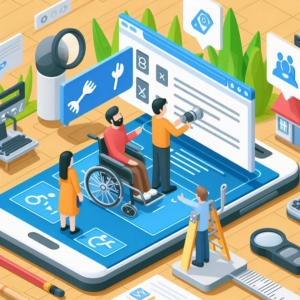Web Accessibility Using the Axe Tool

Introduction
Web accessibility is essential for ensuring that digital content is usable by individuals with various disabilities. It enables inclusive access to information and functionality across different platforms. One of the most effective ways to enhance web accessibility is by utilizing tools like Axe, which helps developers detect and fix accessibility issues efficiently. In this blog, we explore how to integrate the Axe tool into your development workflow, identify accessibility barriers, and implement fixes for a more inclusive web experience.
Understanding the Axe Tool for Web Accessibility
Axe is a powerful accessibility linter that seamlessly integrates with development environments like Visual Studio Code. Once installed, it automatically scans HTML code for accessibility violations and provides actionable insights for resolving them. By leveraging the Axe tool, developers can proactively address accessibility concerns early in the development process.

Code Snippet 1
Here is a simple HTML example that demonstrates the usage of the Axe tool:
“`html
“`
Identifying Accessibility Issues
When running the Axe tool in Visual Studio Code, you might encounter accessibility errors. In the code above, the tag lacks an alternative text description. Hovering over the
tag will display the Axe linter error message, indicating the issue.
Error Code for Snippet 1
The error message generated by the Axe tool is as follows:
axe-linter (image-alt): Ensures elements have alternate text or a role of none or presentation [axe-linter(image-alt)](https://dequeuniversity.com/rules/axe/4.7/image-alt?application%3Daxe-linter).
Fixing Accessibility Issues
To resolve the accessibility issue identified, consider the following fixes:
1. Fix – Add alt attribute.
“`html
“`
2. Fix – Using aria-label attribute.
“`html
“`
3. Fix – Using aria-labelledby attribute.
“`html
“`
After applying any of these fixes, the Axe linter will no longer highlight the error.

With the adjustments made, the code is now free of accessibility errors. This is just one example of many implementations that can be found in this series of blogs.
Further Reading
For more insights, check out the next part in this series: [Part 4 – Web Accessibility: NVDA Screen Reader for effective debugging](https://www.tothenew.com/blog/part-4-web-accessibility-nvda-screen-reader-for-effective-debugging/).
Conclusion
By incorporating Axe into the development process, developers can significantly enhance web accessibility, making digital experiences more inclusive for all users. Implementing accessibility best practices not only improves usability but also aligns with compliance standards like WCAG and ADA. As web technologies evolve, designing for accessibility will play a crucial role in shaping the future of the internet—paving the way for a seamless Web 3.0 experience.
Do you like to read more educational content? Read our blogs at Cloudastra Technologies or contact us for business enquiry at Cloudastra Contact Us.